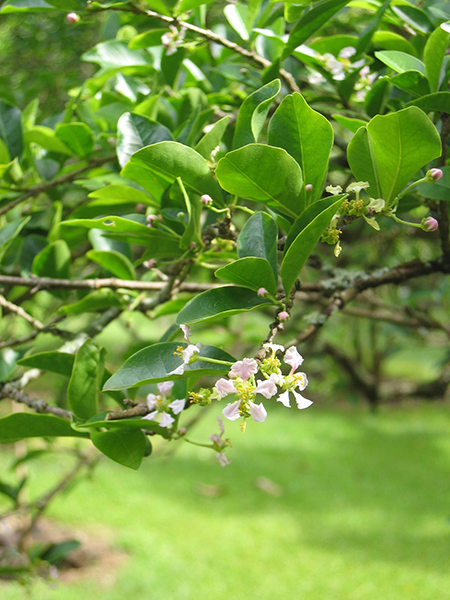Tropical Plant Database - Plant Details
Malpighia emarginata
Conservation Status
- IUCN: data deficient
- USFWS: None
Genus: Malpighia
Species: emarginata
Species Author: Moçiño & Sessé ex DC.
Vernacular: Acerola, Barbados Cherry
The Barbados Cherry is a large, bushy shrub or small tree attaining up to 20 ft (6 m) in height and an equal breadth with more or less erect or spreading and drooping, minutely hairy branches, and a short trunk to 4 in (10 cm) in diameter. Its evergreen leaves are elliptic, oblong, obovate, or narrowly oblanceolate, somewhat wavy, 3/4 to 2 3/4 in (2-7 cm) long, 3/8 to 1 5/8 in (9.5-40 mm) wide, obtuse or rounded at the apex, acute or cuneate at the base, bearing white, silky, irritating hairs when very young and hairless, dark green, and glossy when mature. The flowers, in sessile or short-peduncled cymes, have 5 pink or lavender, spoon-shaped, fringed petals. The fruits, borne singly or in 2's or 3's in the leaf axils, are oblate to round, cherry-like but more or less obviously 3-lobed, 1/2 to 1 in (1.25-2.5 cm) wide, bright-red, with thin, glossy skin and orange-colored, very juicy with acid to subacid pulp. The 3 small, rounded seeds each have 2 large and 1 small fluted wings, thus forming what are generally conceived to be 3 triangular, yellowish, leathery-coated, corrugated inedible "stones". (Morton, J. 1987. Fruits of Warm Climates.)
The fruits are considered beneficial to patients with liver ailments, diarrhea and dysentery, as well as those with coughs or colds. The juice may be gargled to relieve sore throat. (Morton, J. 1987. Fruits of Warm Climates.)
Physicians in Curacao report that children often require treatment for intestinal inflammation and obstruction caused by eating quantities of the entire fruits, including seeds, from the wild Barbados Cherry which abound on the island. People who pick Barbados cherries without gloves and long sleeves may suffer skin irritation from contact with the minute stinging hairs on the leaves and petioles. (Morton, J. 1987. Fruits of Warm Climates.)
The bark of the tree contains 20-25% tannin and has been utilized in the leather industry. The wood is surprisingly hard and heavy. Trials have demonstrated that it refuses to ignite even when treated with flammable fluid unless perfectly dry. (Morton, J. 1987. Fruits of Warm Climates.)
The Barbados Cherry is native to the Lesser Antilles from St. Croix to Trinidad, also Curacao and Margarita and neighboring northern South America as far south as Brazil. It has become naturalized in Cuba, Jamaica and Puerto Rico after cultivation, and is commonly grown in dooryards in the Bahamas and Bermuda, and to some extent in Central and South America. (Morton, J. 1987. Fruits of Warm Climates.)
Barbados Cherries are eaten out-of-hand, mainly by children. For dessert use, they are delicious merely stewed with whatever amount of sugar is desired to modify the acidity of the particular type available. The seeds must be separated from the pulp in the mouth and returned by spoon to the dish. Many may feel that the nuisance is compensated for by the pleasure of enjoying the flavorful pulp and juice. Otherwise, the cooked fruits must be strained to remove the seeds and the resulting sauce or puree can be utilized as a topping on cake, pudding, ice cream or sliced bananas, or used in other culinary products. Commercially prepared puree may be dried or frozen for future use. The fresh juice will prevent darkening of bananas sliced for fruit cups or salads. It can be used for gelatin desserts, punch or sherbet, and has been added as an ascorbic acid supplement to other fruit juices. The juice was dried and powdered commercially in Puerto Rico for a decade until the cost of production caused the factory to be closed down. The fruits may be made into syrup or, with added pectin, excellent jelly, jam, and other preserves. Wine made from Barbados cherries in Hawaii was found to retain 60% of the ascorbic acid. (Morton, J. 1987. Fruits of Warm Climates.)
- 044587 - collected by Joel Lau in 1985
- 044588 - collected by Tim Flynn in 1986
- 044589 - collected by Tim Flynn in 1989
- 006674 - collected by David H. Lorence in 1990
We currently have 4 herbarium specimens for Malpighia emarginata in our collection. Click on any specimen below to view the herbarium sheet data.
.svg)













